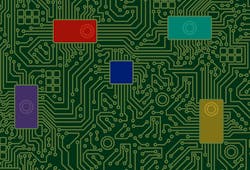Virtual Circuits Beat Out Quantum Computer
This article is part of the April 1st series in the Humor section of our Series Library.
You can also download the PDF eBook of this series.
What you’ll learn:
- What are virtual circuits (VCs)?
- Why VCs are better than quantum computing.
- How chatbots can help in the design of VCs.
Quantum computing promises to deliver impressive computing performance for certain types of problems. They don’t replace conventional computing systems but rather complement them by being able to address those select class of problems using quantum mechanics.
The size of a quantum computer is specified by the number of qubits. Qubits are analogous to bits in a conventional computer because it’s a measure of information. However, the comparison diverges when discussing how to program a quantum computer. The scope of this discussion is well beyond this article, but one of the attributes of quantum computers is performance.
Quantum computers can generate essentially all of the possibilities for a particular problem pretty much instantaneously, or so they say. In any case, that’s faster than the usual array of cores in a cloud computer but not faster than our virtual circuits (VC).
What are Virtual Circuits?
We had some help designing our virtual-circuit technology, but more on that later. VCs are essentially conventional analog and digital circuits in the virtual realm (Fig. 1). Since they’re virtual, they can run as fast as they want with no latency because natural laws can’t get in the way.
Of course, keeping the same functionality and layout as the real circuits means that all of the tooling needed to make a real system can be used for virtual circuits. They’re just constructed in the virtual space.
Making a virtual machine (VM) is just a matter of combining multiple virtual-circuit boards (VCBs). Keep in mind that these VMs are different than the VMs running under a hypervisor in a conventional computer. We just used the same terminology to confuse VC investors. You need a 64-bit VM to compare to a 1024-qubit quantum computer.
Comparing virtual-circuit performance was a challenge. Finding the right way to do it helped, since quantum computers and conventional circuits are so different. The chart shows how the three stack up against each other when computing all of the values for a square pi (Fig. 2). The results are circular in nature, but that has to do more with the quantum qubits.
Designing VCs
You might think that VCs are hard to design, but you can do the same thing we did. We simply posed this question to our chatbot, GobblDGOOK:
“Design a class of circuits that breaks all laws and beats out a quantum computer in terms of performance and accuracy.”
We decided ChatGPT and Bing’s AI were too biased, so we built and trained our own.
Though it did come up with some silly results, we improved the results by eliminating natural laws from its training data. We limited it to laws approved, rejected, and reconsidered by the Supreme Count of the United States (SCOTUS) and the proposed laws from the U.S. House of Representatives. As you can see, the results were as expected. It just took until April 1st to get the results out to the world. Enjoy.
Read more articles like this in our April 1st series in the Humor section of our Series Library.
About the Author
William G. Wong
Senior Content Director - Electronic Design and Microwaves & RF
I am Editor of Electronic Design focusing on embedded, software, and systems. As Senior Content Director, I also manage Microwaves & RF and I work with a great team of editors to provide engineers, programmers, developers and technical managers with interesting and useful articles and videos on a regular basis. Check out our free newsletters to see the latest content.
You can send press releases for new products for possible coverage on the website. I am also interested in receiving contributed articles for publishing on our website. Use our template and send to me along with a signed release form.
Check out my blog, AltEmbedded on Electronic Design, as well as his latest articles on this site that are listed below.
You can visit my social media via these links:
- AltEmbedded on Electronic Design
- Bill Wong on Facebook
- @AltEmbedded on Twitter
- Bill Wong on LinkedIn
I earned a Bachelor of Electrical Engineering at the Georgia Institute of Technology and a Masters in Computer Science from Rutgers University. I still do a bit of programming using everything from C and C++ to Rust and Ada/SPARK. I do a bit of PHP programming for Drupal websites. I have posted a few Drupal modules.
I still get a hand on software and electronic hardware. Some of this can be found on our Kit Close-Up video series. You can also see me on many of our TechXchange Talk videos. I am interested in a range of projects from robotics to artificial intelligence.



